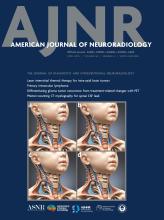This article requires a subscription to view the full text. If you have a subscription you may use the login form below to view the article. Access to this article can also be purchased.
SUMMARY:
Light-chain deposition disease (LCDD) is a rare CNS disorder characterized by the extracellular accumulation of monoclonal immunoglobulin light chains in various organs. LCDD typically arises secondary to an underlying plasma cell dyscrasia, such as monoclonal gammopathy of undetermined significance or multiple myeloma. However, rare cases can occur in the absence of a demonstrable plasma cell disorder. The kidneys, liver, lungs, and heart are the most affected organs. Intracerebral LCDD, particularly without an underlying plasma cell neoplasm, represents an exceedingly uncommon entity with limited documented cases in the literature. This review article explores the pathogenesis, histopathologic features, and characteristic neuroimaging findings of intracerebral LCDD. We emphasize the diverse imaging presentations of this disease, which can closely resemble other neurologic pathologies. Recognizing these potential mimics is crucial for avoiding misdiagnosis, especially in the absence of a known underlying plasma cell disorder. This article aims to provide a comprehensive overview from a neuroradiologic perspective, facilitating the recognition and differentiation of this challenging entity.
ABBREVIATIONS:
- ALD
- amyloidoma
- Ig
- immunoglobulin
- LC
- light chain
- LCDD
- light-chain deposition disease
- MIDD
- monoclonal immunoglobulin deposition disease
- © 2025 by American Journal of Neuroradiology












